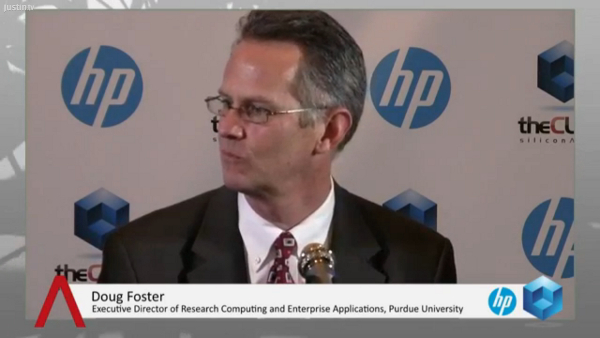 NEWS
NEWS
 NEWS
NEWS
 NEWS
NEWS
Doug Foster, Executive Director, Research Computing and Enterprise Applications at Purdue University discussed the many applications of the just announced HP Moonshot technology with the Cube’s hosts John Furrier and Dave Vellante at the New York launch event, exploring the impact on both the academic and business environments.
![]()
From a researcher’s point of view, infrastructure becomes important as the x86 server architecture is no longer able to “move at the speed we need it to move, we can’t keep up.” With the introduction of Moonshot, HP manages to address specific infrastructure problems and requirements of research computing.
Doug Foster explained that the new Moonshot server will help reduce the university’s need for specific hardware and, in the long run, simplify infrastructure maintenance. He also pointed out that the power saving HP’s new technology promises (80 percent less than an x86 server) is a very important advantage.
“We have a great relationship with HP, we use their servers in our research clusters,” Foster explained. “We need HP to help us deliver solutions that aim at specific research problems.” To reach that purpose faster, Purdue engineering students will collaborate with HP employees, and work on the Moonshot project to help each other come up with solutions they need which can be applied in both the academic and business world.
.
.
John Furrier asked Dave Foster to comment on the idea of academics needing the best technology, because they work on the hardest problems. Foster agreed that research in the academic environment means dealing with a variety of problems generated by a very large computing power requirement. Such requirements go into projects such as predicting the weather or earthquakes. The typical research process also requires running the so called “Monte Carlo” simulations – which are not extremely complex or intensive, but there are millions that need to be run, and the new Moonshot provides the right infrastructure for such tasks.
Dave Velante asked about the collaborative Discovery Lab, a project on which Purdue and HP will collaborate. Foster explained that the research lab will be built in the middle of the university’s campus, bringing students and HP staff together to focus on finding new uses for the newly announced Moonshot technology, and to help solve research problems. On its end, HP “will bring business problems to the table and ask students to solve these problems.”
Foster also predicted that “a lot more organizations are going to start participating in cloud-based computing,” as they start questioning their need to run their own infrastructure. Speaking of the applications for Moonshot, he pointed out that it feels we are at the beginning of something, and that it is hard to predict where it will go. However, Purdue aims to help steer some of the future applications through its Discovery Lab.
.
.
Moving forward to the appliances in the business world, Foster pointed that one of the most important problems in IT is the need to bridge gaps when it comes to addressing businesses. A lot of people in the business environment don’t really understand what’s happening in the tech world, or why they should care about newly introduced technology To make the right strategic investment “they need to understand, in business terms, why it matters.” The best selling points for corporations would be the reduction in power consumption and in price.
Research universities come from a completely different environment. “We are very uncomfortable with putting our data in the cloud,” mostly because of concerns about intellectual property being exposed. A big issue is figuring the economics of how to get the needed services delivered the fastest and cheapest. The speed component is quite important and that is why Moonshot is so interesting. The discussions are currently about spaces where researchers are not worried about IP – an agile, quickly configurable environment, where cost and time are taken into consideration.
“We are committed to driving costs overhead out of the box and driving it into the things that drive our university – research and teaching,” Foster added. It is the same for corporate organizations, in his opinion.
Asked to advise CIOs on the corporate side in terms of technology investments for the next five years, Foster explained that when it comes to IT shifts, there is a first a period of confusion – what do I do with it, how it applies. Therefore in the short term, CIOs need to get a deep understanding of the Moonshot technology and see how it can solve their specific problems. Those who can figure it fast enough will be the big winners. Those who will fail to see how the technology applies to their field will be left behind.
Follow Moonshot’s story
We’re live at HP’s Moonshot event all day, bringing you exclusive interviews with HP executives and partners. Watch the stream here on SiliconAngle, and catch the archived clips on our YouTube channel.
Support our mission to keep content open and free by engaging with theCUBE community. Join theCUBE’s Alumni Trust Network, where technology leaders connect, share intelligence and create opportunities.
Founded by tech visionaries John Furrier and Dave Vellante, SiliconANGLE Media has built a dynamic ecosystem of industry-leading digital media brands that reach 15+ million elite tech professionals. Our new proprietary theCUBE AI Video Cloud is breaking ground in audience interaction, leveraging theCUBEai.com neural network to help technology companies make data-driven decisions and stay at the forefront of industry conversations.